#David Yallop
Text
Five Biggest History Conspiracy Theories
My five favourite history conspiracy theories - a guilty pleasure at yuletide!
#history
Conspiracy theories are nothing new. We’re more aware of them today thanks to the ceaseless buzz of social media. But back in ancient Rome, Nero was blaming Christians for burning down the city. While in Stuart London after the Great Fire of 1666, a monument was erected pointing an accusing finger at Roman Catholics as devious arsonists.
What’s often not recognised is the extent to which…

View On WordPress
#Abraham Lincoln assassination#conspiracy theories#conspiracy theory#David Yallop#death#Godfather III#history#Hitler alive#JFK assassination#John Paul I murdered#Knights Templar origins#Nazis south America#Priory of Sion
2 notes
·
View notes
Text
youtube
Quando o riso parou: a história de um ídolo de Hollywood destruído pelas fake News
#Roscoe Arbuckle#fake news#old hollywood#Fatty Arbuckle#silent film#Virginia Rappe#scandal#The Day the Laughter Stopped#David Yallop#Youtube
1 note
·
View note
Text
Five Biggest History Conspiracy Theories
My five favourite history conspiracy theories - a guilty pleasure at yuletide!
#history
Conspiracy theories are nothing new. We’re more aware of them today thanks to the ceaseless buzz of social media. But back in ancient Rome, Nero was blaming Christians for burning down the city. While in Stuart London after the Great Fire of 1666, a monument was erected pointing an accusing finger at Roman Catholics as devious arsonists.
What’s often not recognised is the extent to which…
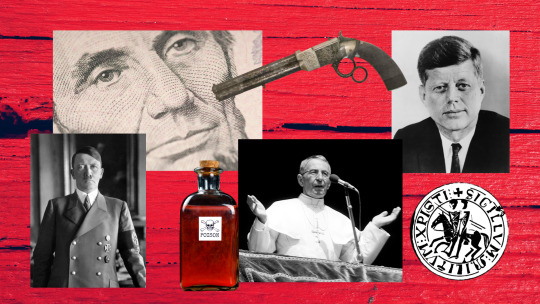
View On WordPress
#Abraham Lincoln assassination#conspiracy theories#conspiracy theory#David Yallop#death#Godfather III#history#Hitler alive#JFK assassination#John Paul I murdered#Knights Templar origins#Nazis south America#Priory of Sion
0 notes
Photo

To The Ends Of The Earth ~ David Yallop
0 notes
Text

Por que o caixão do Papa é trapezoidal?
Por Cláudio Tsuyoshi Suenaga
Os milhares de fiéis que se reuniram às portas da Basílica de São Pedro, na Cidade do Vaticano, bem como os que sintonizaram os seus aparelhos para acompanhar o funeral de Bento XVI (Papa de 2005 a 2013, falecido em 31 de dezembro último) nesta quinta-feira, 5 de janeiro, devem ter notado o formato estranhamente trapezoidal de seu caixão.
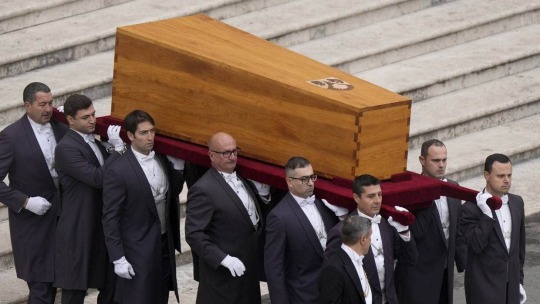
O caixão trapezoidal do falecido Papa Emérito Bento XVI é levado à Praça de São Pedro para a missa fúnebre no Vaticano. Foto: Ben Curtis/VIA PA WIRE.
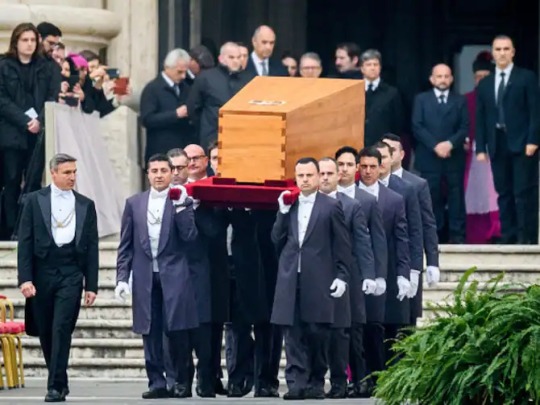
Carregadores levam o caixão trapezoidal do Papa Emérito Bento XVI na missa fúnebre na Praça de São Pedro, no Vaticano, em 5 de janeiro. Fonte: AFP.

O Livro dos Evangelhos repousa sobre o caixão trapezoidal do Papa Bento XVI durante sua missa fúnebre na Praça de São Pedro no Vaticano em 5 de janeiro de 2023. Na noite anterior ao funeral, quando seu corpo foi colocado no caixão, o Vaticano também colocou nele um tubo de metal contendo um texto de 1.000 palavras, conhecido como “rogito”, resumindo sua vida e ministério. Foto CNS/Paul Haring
E certamente todos devem estar lembrados que o caixão de João Paulo II (Papa de 1978 a 2005) apresentava o mesmo formato em seu funeral em 8 de abril de 2005.
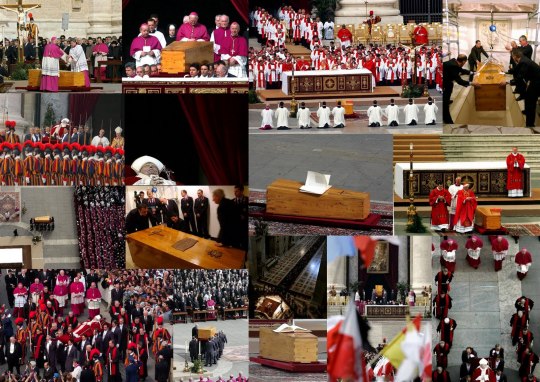

O então cardeal Joseph Ratzinger abençoa o caixão trapezoidal do Papa João Paulo II durante seu funeral na Praça de São Pedro em 8 de abril de 2005. Foto de Kay Nietfeld/dpa/Corbis.

O então cardeal Joseph Ratzinger incensa o caixão trapezoidal do Papa João Paulo II em seu funeral em 8 de abril de 2005. Foto: Nick Cornish.
Bem como o de João Paulo I (Papa que assumiu em 26 de agosto e morreu exatamente 33 dias depois, ou seja, o mesmo número de graus da Maçonaria, em 28 de setembro de 1978) e de seus antecessores. De origem humilde e apelidado de "Papa Sorriso" por sua afabilidade, Albino Luciani queria expulsar do Vaticano os Cardeais e eclesiásticos envolvidos no escândalo do Banco Ambrosiano, os quais tinham ligações com a loja maçônica P2 de Lício Gelli e com a Máfia de Michele Sindona que teriam se infiltrado no Vaticano por meio de suas ligações com o Papa Paulo VI (1897-1978, eleito em 1963). Cerca de 15 dias antes dele, morrera também e de modo misterioso o Metropolita Nikodim, arcebispo ortodoxo russo de Leningrado e Novgorod de 1963 até sua morte e agente do Serviço Secreto Soviético, o Comitê para Segurança do Estado [Komitet Gosudartsvennoi Besorpasnosti (KGB)]. Sobre o assunto, recomenda-se a leitura do livro In God's Name: An Investigation on the Murder of Pope John Paul I, de David A. Yallop (New York, Bantam Books, 1994).

O caixão trapezoidal do Papa João Paulo I em seu funeral na Cidade do Vaticano em 4 de outubro de 1978. Foto de Sérgio del Grande.
Não consegui descobrir quando exatamente começou esta tradição na Igreja, que certamente remonta há séculos. O que pude apurar é que os Papas não são sepultados em apenas um, mas em três caixões que cabem todos dentro dos outros. E com Joseph Ratzinger, o primeiro pontífice a renunciar em 600 anos (algo que não acontecia desde Gregório VII, que renunciou em 4 de julho de 1415, após 8 anos), não foi diferente.
Primeiro o corpo é colocado em caixão feito de madeira de cipreste, onde são apresentadas as moedas do seu pontificado, bem como o pálio e um texto que resume o seu trabalho como Papa. Este último objeto é instalado em um cilindro de metal. Posteriormente, este sarcófago é inserido em um metálico. Após a colocação de uma fita com os selos oficiais no primeiro, este é colocado no segundo, que é lacrado e soldado após a missa. Finalmente, o catafalco duplo é colocado em um caixão de madeira, e este é introduzido nas Grutas do Vaticano. Bento XVI foi sepultado no lugar ocupado por seu predecessor, João Paulo II. Os restos mortais do Papa polonês foram trasladados após sua beatificação para a Capela de São Sebastião, localizada na Basílica de São Pedro no Vaticano.
Cabe destacar que esta foi a primeira vez na história da Igreja que um Papa oficiou a cerimônia para um Sumo Pontífice anterior. O discurso do Papa Francisco durante o funeral foi realizado sob o rito Ordo exequiarum Romani Pontificis, conforme estabelecido na Constituição Apostólica Universi Dominici Gregis de 1996.
Mas, afinal, por que o formato do caixão do Papa é trapezoidal? Decifremos o simbolismo profundo e oculto que se encerra por trás.
O trapézio é definido como “um quadrilátero com dois lados paralelos”, sem que haja uma exigência quanto a quais dois lados devem ser paralelos e quais dos lados têm que se unir. O trapézio é a forma que constitui a base de uma pirâmide, ou seja, nenhuma pirâmide é erguida sem que antes se erga uma base que tenha um formato trapezoidal. Pode-se dizer, portanto, que é do trapézio que nasce a pirâmide. E a pirâmide representa a hierarquia, a basedominada pelo topo, a árdua ascensão degrau por degrau a uma etapa evolutiva superior até a conquista suprema da plenitude ou perfeição divina.
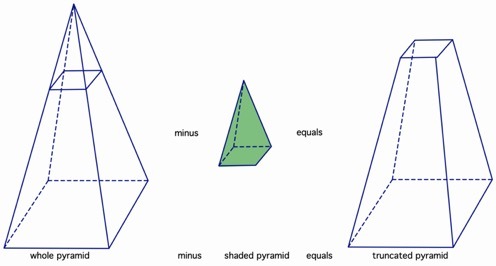
É o símbolo messiânico por excelência, motivo pelo qual Cristo é levado por Satanás, quando este o tentava no deserto, ao pináculo do templo mais alto da época que não era outro do que o ápice da Pirâmide de Quéops. Pelo mesmo motivo, a pirâmide truncada tendo no seu ápex o “Olho da Providência”, o “Olho que Tudo Vê” ou o “Olho de Hórus”, o símbolo da “iluminação” luciférica para maçons e illuminati, se encontra no verso da nota de um dólar. A imagem do selo retrata a pirâmide como símbolo do Reino da Pedra, com a Pedra Apical simbólica de Cristo, a pedra angular suspensa sobre o eixo do centro da estrutura, que fica incompleta sem ela. Porém, logicamente, o Jesus do Cristianismo nada tem a ver com o Jesus da Maçonaria.

O triângulo com o olho que tudo vê para os maçons é justamente a pedra angular que rejeitaram, ou seja, Cristo, razão pela qual transformaram a pirâmide perfeita em um trapezoide, que é um símbolo de frustrações, e disfarçaram a falsa pirâmide com o triângulo e o Olho de Lúcifer, que é o verdadeiro deus da Maçonaria, a qual aliás já controlava o sistema religioso judaico no início da Era Cristã.
Ao longo das antigas escrituras, Jesus Cristo é invariavelmente comparado com a pedra angular de uma estrutura, a pedra angular da base de um edifício, o que segura toda a construção. Davi já se referia ao Senhor em conexão com uma “pedra angular (de capeamento)” futura: “A pedra que os edificadores rejeitaram, essa foi posta como pedra angular. Foi o Senhor que fez isto e é maravilhoso aos nossos olhos” (Salmo 118:22-23). Zacarias 4:7 se refere à colocação futura de Deus de uma pedra no topo de sua estrutura concluída: “ele trará a pedra angular com aclamações: Graça, graça a ela”. Isaías 28:16 se refere ao Messias como a “pedra angular preciosa”. Notavelmente, Jesus Cristo aplicou esta mesma profecia a Si mesmo, mostrando que era a “pedra rejeitada”.
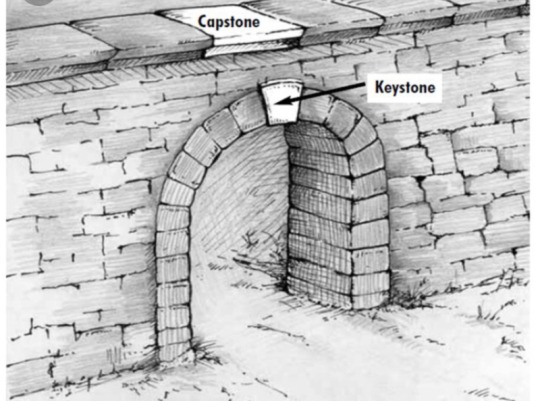
Israel, sob a liderança dos fariseus e mestres religiosos, o rejeitou como o Messias, por isso Jesus usou o Salmo de Davi para ilustrar o Seu ponto dramático diante das multidões: “Disse-lhes Jesus: Nunca lestes nas Escrituras: A pedra que os edificadores rejeitaram, essa foi posta como pedra angular; pelo Senhor foi feito isso, e é maravilhoso aos nossos olhos?” (Mateus 21:42). Mais tarde, em um dos grandes sermões de Pedro ao povo judeu, ele retorna a esta mesma profecia: “Este Jesus é pedra rejeitada por vós, os construtores, a qual se tornou a pedra angular. E em nenhum outro há salvação; porque debaixo do céu nenhum outro nome há, dado entre os homens, em que devamos ser salvos” (Atos 4:11-12).
Nas construções antigas, a pedra angular era a pedra de esquina que servia para alinhar toda a construção. A escolha de uma boa pedra facilitaria a construção conforme a planta. Uma pedra fora de esquadria resultaria numa construção errada. Os construtores de Israel julgavam Jesus uma pedra inadequada para o tipo de construção que eles queriam. Deus o julgou perfeito para edificar a Igreja conforme a planta divina. Ora, tendo presente que a pedra angular é a pedra fundamental que forma o ângulo externo de um edifício, e é posta no ângulo de encontro de duas paredes e as mantém ligadas, o fato de Jesus Cristo ser chamado “a pedra angular no qual todo o edifício é ajustado e cresce para tornar-se um santuário santo no Senhor” (Efésios 2:21), indica que Ele é a pedra fundamental sobre quem foi construída a Igreja de Deus, ou seja, o edifício espiritual que serve para morada de Deus em Espírito.
No entanto, em uma pirâmide egípcia, a pedra angular (capstone) é a parte superior (uppermost piece) e está, portanto, no topo (pyramidion).Em egípcio antigo, eram chamadas de benbenet. No Antigo Reino, as pyramidia eram geralmente feitas de diorito, granito ou calcário fino e cobertas de ouro ou electrum (termo latino, também usado para o âmbar, para uma liga de ouro e prata com parcelas de cobre e outros metais). Durante o Império Médio e até o fim da era da construção de pirâmides, eram feitas de granito negro polido e muitas vezes receberam inscrições com títulos reais e símbolos religiosos.
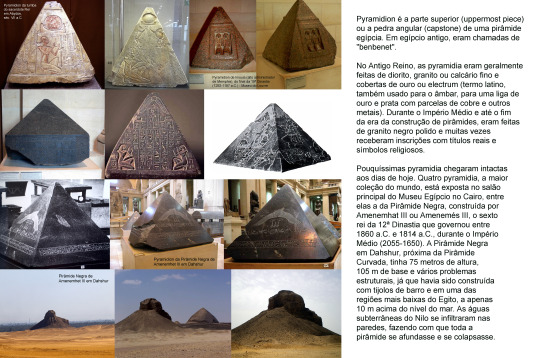
Pouquíssimas pyramidia chegaram intactas aos dias de hoje. Quatro pyramidia, a maior coleção do mundo, está exposta no salão principal do Museu Egípcio no Cairo, entre elas a da Pirâmide Negra, construída por Amenemhat III ou Amenemés III, o 6º rei da 12ª Dinastia que governou entre 1860 e 1814 a.C., durante o Império Médio (2055-1650 a.C.). A Pirâmide Negra em Dahshur, próxima da Pirâmide Curvada, tinha 75 metros de altura, 105 metros de base e vários problemas estruturais, já que havia sido construída com tijolos de barro e em uma das regiões mais baixas do Egito, a apenas 10 metros acima do nível do mar. As águas subterrâneas do Nilo se infiltraram nas paredes, fazendo com que toda a pirâmide se afundasse e se colapsasse. É muito interessante observar que hoje a Grande Pirâmide de Gizé não tem uma pedra angular de capeamento – que alguns dizem ter sido roubada por maçons há séculos atrás. Na verdade, não há qualquer registro histórico de tal pedra jamais ter sido vista na Grande Pirâmide.
É exatamente por este motivo que o caixão do Papa é trapezoidal e vários edifícios espalhados ao redor do mundo foram construídos no mesmo formato. O John Hancock Center, em Chicago, junto ao Lago Michigan, é um dos mais notórios. Com 344 metros de altura (467 metros com a antena) e 100 andares, é terceiro prédio mais alto de Chicago e o quarto mais alto dos Estados Unidos, perdendo apenas para o Sears Tower, o Empire State Building e o Aon Center. Projetado pelo engenheiro Fazlur Khan do escritório Skidmore, Owings and Merrill LLP (SOM), começou a ser construído em 1965 e foi inaugurado em 1969. Sua estrutura é capaz de resistir a violentos terremotos.

Em plena Avenida Paulista, bem em frente ao Metrô Trianon-MASP (Trianon = Triângulo, Pirâmide), no centro de São Paulo, está o Edifício Luís Eulálio de Bueno Vidigal Filho (ex-presidente da FIESP), tradicional sede da FIESP (Federação das Indústrias do Estado de São Paulo). Projetada pelo escritório de arquitetura de Rino Levi Arquitetos Associados e inaugurada em 1979, a pirâmide negra trapezoidal de 99 metros de altura e 16 andares ocupa o nº 1313 (cabalístico para maçons e illuminati) e fica escondida entre dois prédios mais altos.




O Edifício Luís Eulálio de Bueno Vidigal Filho, sede da FIESP em forma trapezoidal na Avenida Paulista nº 1313. Fonte: Internet.

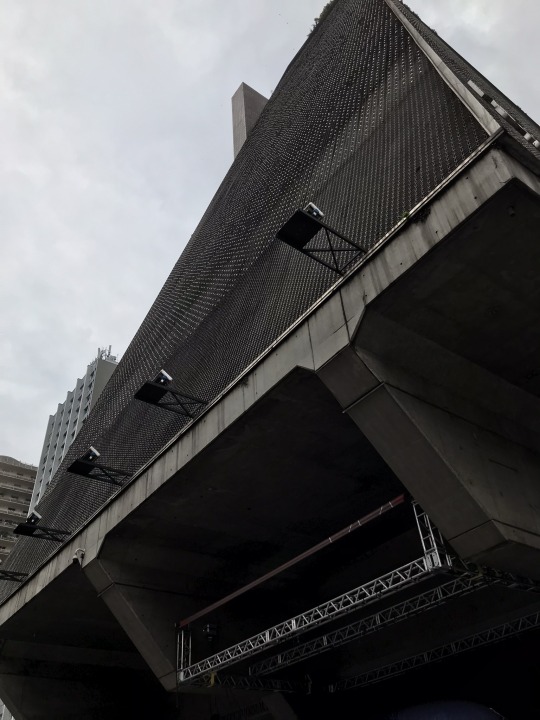
O Edifício Luís Eulálio de Bueno Vidigal Filho, sede da FIESP em forma trapezoidal na Avenida Paulista nº 1313. Fotos de Cláudio Suenaga.

O Edifício Luís Eulálio de Bueno Vidigal Filho, na Avenida Paulista nº 1313. Foto de Cláudio Suenaga.

Curiosamente, ali bem próximo, na praça do outro lado da rua do prédio trapezoidal da FIESP, o número 666 foi "plantado" em forma de vegetação para ser visto do alto. Fonte: Google earth.
Quanto ao número 13, note que nos desenhos no verso da cédula de um dólar que faz parte do Grande Selo dos Estados Unidos, a pirâmide tem 13 degraus que representam os 13 Estados originais, bem como as 13 linhagens de sangue (bloodlines) Illuminati que governam o planeta. A águia, símbolo do poder usado desde sempre por todas as antigas civilizações do planeta, segura um ramo de oliveira em uma pata e 13 flechas na outra, que representam o poder da paz e da guerra, respectivamente. Sobre a cabeça da águia, há 13 estrelas que formam o símbolo da Estrela de Davi. A quantidade de penas nas asas (32 e 33) e cauda da águia (9), são referências aos números de graus da maçonaria e ao Conselho dos 9 que governam o mundo.
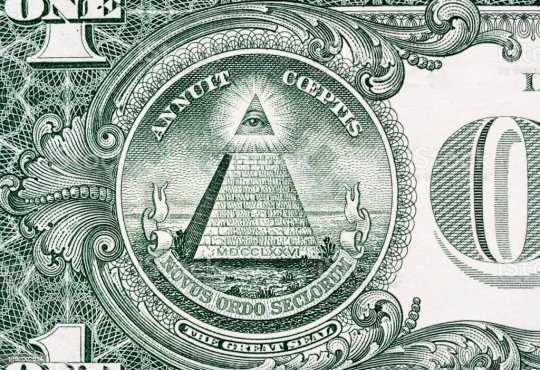

Por trás da forma trapezoidal existe algo de muito mais pesado, como se já não bastasse a invocação maçônica-illuminati. Trapezoide seria o nome de uma sociedade secreta muito antiga, adoradora de Set, o deus egípcio do caos, da seca, da guerra, da confusão, da desordem e da perturbação, a contraparte negativa de seu irmão Osíris, deus da terra fértil e nutritiva, e em constante rivalidade com seu sobrinho Hórus. Set seria assim a versão egípcia do Satanás bíblico.
A estudiosa do ocultismo Cathy Burns, formada em Filosofia Bíblica e que passou duas décadas fazendo uma extensa pesquisa sobre sociedades secretas, o Movimento Nova Era e assuntos correlatos, em seu livro, Billy Graham and His Friends: A Hidden Agenda? (Sharing, 2006), descreve a “Ordem do Trapézio” e suas raízes na antiga sociedade secreta que adora o antigo deus egípcio Set, ou Satanás.
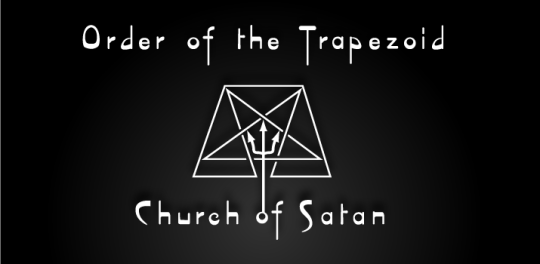
Em seus escritos ela cita o satanista Anton Szandor LaVey (1930-1997), fundador em 1966 da Igreja de Satanás e autor da Bíblia Satânica (1969): “O trapézio há muito é considerado pelos ocultistas como a forma mais satânica, especialmente adaptada para aumentar a manifestação demoníaca. De fato, a ordem intermediária da irmandade satânica é chamada de ‘A Ordem do Trapézio’. Anton LaVey, o fundador da Igreja de Satã, refere-se a um princípio oculto conhecido como a ‘Lei do Trapézio’. Seus escritos ressaltam a existência de uma ciência mágica de ângulos e espaços geométricos que é muito prevalente na Sala de Meditação da ONU... LaVey diz que a arquitetura pode transmitir uma atmosfera espiritual maligna. O ponto principal de tudo isso é que a forma arquitetônica consumada do adorador de Satanás é o trapézio; e ele acredita que essa forma criará uma espécie de ‘câmara de nuvens’ espiritual através da qual ele poderá rastrear as pegadas dos demônios que deseja invocar. Acredita-se que seja a atmosfera perfeita para a manifestação do profano e do amaldiçoado.”

Um folheto oficial da Igreja de Satanás que prova a existência da "Ordem do Trapézio".

Este medalhão exclusivo é uma recriação inspirada no design original de Anton LaVey, criado antes da formação da Igreja de Satanás. A forma do caixão é essencialmente dois trapézios unidos pela base, uma forma arquetípica intrigante, atraente e intimidante, insinuando uma ameaça sobrenatural. O Medalhão foi usado por Anton LaVey e membros selecionados da Ordem do Trapézio e se encontra à venda no site da Church of Satan.

Esta é a Terceira e Última Ordem Recriada do Medalhão Trapeoidal baseada no medalhão mágico original usado por Anton Szandor LaVey nos primeiros dias da Igreja de Satanás. LaVey escreveu sobre o poder do trapézio de dobrar o tempo, o espaço e a consciência em direção aos caminhos dos pesadelos e da revelação infernal. Por incrível que pareça, tal produto está à venda no site da Igreja de Satanás.
O caixão trapezoidal seria uma só uma referência à pirâmide truncada ou indicaria a interferência de um de “superpoder” sinistro que cercou e tomou o Vaticano e toda a Cúria?
#vaticano#vatican#pope benedict xvi#papa benedetto xvi#funeral#igrejacatolica#igreja católica#catolicismo#papa francesco#papa francisco#fiesp#avenidapaulista#arquitetura
8 notes
·
View notes
Note
Hi! Have you seen the sort-of-Monty Python, humourously-yet-bittersweetly-funny animated-collab biopic tribute film "A Liar's Autobiography: The Untrue Story of Monty Python's Graham Chapman", that's about life of, well, Graham Chapman, from his childhood to his career to his personal life to, finally, his death, but all in a exaggerately funny and (probably not all true) way? The whole entire movie's available to watch on YouTube, btw, so give it a watch if you can!
Fun Fact: the film is actually based off Graham's comical semi-autobiographical book "A Liar's Autobiography: Volume VI" (yes, it's really called that, and no, there are no preceding books before that one, it's just the one), in which it actually credits inside the book 4 other writers besides Graham, which include his partner David Sherlock, Douglas Adams (of Hitchhiker's Guide to the Galaxy fame), Alex Martin and David A. Yallop.
I NEED TO WATCH THIS.
3 notes
·
View notes
Text

El 28 de Septiembre de 1978, en la ciudad del Vaticano, un mes después de ser elegido Papa, en misteriosas circunstancias moría “Juan Pablo I”. Albino Luciani, se desempeñaba como Obispo de Venecia cuando en 1972, por orden del papa “Paulo VI”, el Banco Vaticano vendió al Banco Ambrosiano la Banca Cattolica del Veneto. Esto enfureció a Luciani, ya que conocía los vínculos del ambrosiano con la mafia. Cuando en Agosto de 1978 falleció “Paulo VI”, el cónclave vaticano eligió a Albino Luciani por sobre Giuseppe Siri y Karol Wojtila, y eligió el nombre de “Juan Pablo I”. Luciani humanizó el papado, abrazó la humildad para la iglesia, fue el primero en rechazar la ostentosa silla gestatoria y transfirió parte de los ingresos vaticanos a las iglesias del tercer mundo. Entre la agenda heredada del papa anterior, debió recibir al dictador Argentino Jorge Rafael Videla, Luciani lo trató bastante mal y le hizo un enérgico reclamo por sus violaciones a los derechos humanos, la entrevista duró menos de 10 minutos y Videla se retiró enfurecido. Luciani no quería estar relacionado con evasión de impuestos, movimiento ilegal de acciones y lavado de dinero, especialidades del Banco Ambrosiano a cargo de las finanzas Vaticanas. Por ello encargó que le facilitaran los libros contables del vaticano, era el primer Papa en pedirlos. 33 días después de asumir, mientras estudiaba esos documentos en su escritorio, se descompuso y murió de un infarto. La cúpula vaticana, no permitió una autopsia y comenzó de inmediato el proceso de embalsamamiento. Originalmente se dio la versión que la mucama Sor Vicenza Taffarel lo encontró en la cama, pero la versión se desvaneció rápidamente agitando las versiones de un complot para asesinarlo. El investigador inglés David Yallop accedió a documentos secretos donde constaba que tuvo vómitos previos y confirmó que la versión de la muerte mientras dormía era falsa, concluyó que se le había administrado un vasodilatador en dosis mortales, para doblegar su corazón, cuyos análisis previos a asumir lo encontraban en perfecto estado de salud. “Juan Pablo I” fue el último Papa Italiano, su sucesor Karol Wojtila eligió el nombre de “Juan Pablo II” en su honor, pero suspendió todas las investigaciones bancarias, suspendió las transferencias a las iglesias del tercer mundo y regresó a las opulencias tradicionales.
Web
8 notes
·
View notes
Text
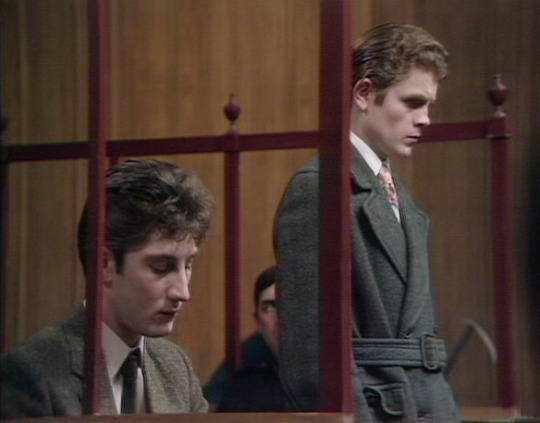



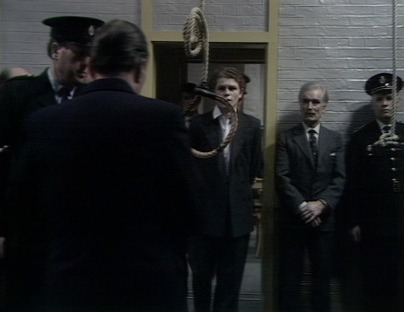
To Encourage the Others (BBC, 1972)
"Sergeant Fairfax has told us that he came and grabbed Bentley, and while you were all there together by the head of the lift shaft, you deliberately shot him -"
"I didn't, sir."
"- having been incited to do so by Bentley saying, 'Let him have it, Chris'. Now, are you saying you did not hear that?"
"Bentley didn't say it."
"Well, three officers heard it in the darkness from different points of the compass. Are you saying he did not say it?"
"I'm saying I didn't hear it, and if they heard it then they got better hearing than mine."
#To encourage the others#alan clarke#BBC#Single play#classic tv#David Yallop#Charles Bolton#Billy Hamon#Roland Culver#Philip Stone#Wensley Pithey#Arthur Lovegrove#Carmel McSharry#John Ringham#Ken Halliwell#Michael Sheard#Christopher Coll#Derrick Slater#A hugely significant work in the filmography of Clarke and indeed an incredibly important piece of British TV. Sometimes described as a#Play for Today altho there's no evidence it was ever transmitted under that banner (it probably had many of the same team working on it tho#That wouldn't be unusual). The Bentley case is lodged in the public consciousness of the UK as one of the most blatant and shocking#Miscarriages of justice in the modern era; this play followed the 71 publication of a book of the same name which sought to clear Bentley's#Name and establish the facts of the case. In the process Clarke and writer Yallop establish the benchmark for producing riveting docudrama;#Court room scenes follow official transcripts and reenactments are cleverly staged as a sequence of bw photographs. For all that it's#Professional and measured in approach you can't miss the subtle rage which beats just below the surface: rage at a system which knowingly#Perverts itself to mete out punishment it feels befitting. Clarke keeps the screen very crowded and tight giving everything a claustrophobi#Desperate feel (which of course is only heightened in the scenes in Bentley's cell). The use of quotation cards and official statement#Extracts is only another carefully considered tool as well; the very final quote (from the then crown prosecution service and informing the#Production team that there was not requisite public interest in reopening Bentley's case 20 years after his death) feels like a punch to#The gut. That it would in fact be another 25 years after this play aired before Bentley was finally pardoned is an affront to all decency.
7 notes
·
View notes
Text
Indian Expeditions Down Under
There is a certain allure to cricket played in Australia. This could be attributed to the massive iconic venues, sunny weather when it is cold and dreary in most parts of the world, revolutionary television coverage pioneered by channel 9 and sporting wickets.
As the test series gets under way in Sydney with the 1st ever day and night match between the two countries, my mind goes back to the battles waged down under since I started following cricket in the 70s. The Aussies were practically invincible at home for most of that decade as they humiliated their bitter rivals England in 74-75 & the mighty Windies in 76-76. I still recall hearing about the exploits of Lillie, Thompson & the Chappell brothers through the crisp commentary of Alan McGilvray & Jim Maxwell on Radio Australia short wave.
There had been only 2 previous tours by India to Australia in 1947-48 & 1967-68. On both occasions, the hosts had won 4-0. Therefore history was against the tourists, when they visited Australia at the end of 1977 after a gap of 10 years, However India were up against a severely weakened team due to the exodus to Kerry Packer’s world series cricket. Only Thompson resisted the temptation of joining the Packer bandwagon and a 41- year old Simpson was recalled after several years of retirement to captain a young and virtually unknown team. It still turned out to be a close series with Australia winning 3-2. Simpson apart from marshalling his young troops well, also scored an epic 176 in the 2nd test at Perth and 100 in the final test in Adelaide with 539 runs in the series. Australia won the first 2 matches at Brisbane and Perth narrowly by 16 runs & 2 wickets respectively. Tony Mann became only the second batsman in test history to score a century as a night watchman at Perth. India came back strongly with thumping wins at Melbourne & Sydney, as the Indian spin trio of Bedi (captain), Chandra & Prasanna wove their magic for the last time in their illustrious careers. Chandra picked up 12 wickets at Melbourne as he bowled India to victory. The final test at Adelaide went down to the wire with Australia romping home by 47 runs as India almost reached the massive 493 set for victory. India felt the absence of a genuine fast bowler and in hindsight could have included Kapil Dev who was just making his mark in domestic cricket. Gavaskar scored 3 consecutive centuries and was well supported by Vishwanath and Mohinder Amarnath, all three finished with over 400 runs in the series. The Aussies uncovered a number of new talents during that series such as Peter Toohey, Rick Darling, Wayne Clarke, Graham Yallop, Gary Cozier & Craig Sarjeant.
The Packer boys had come back by the time India toured next in 1980-81. Thompson & Ian Chappell were no longer playing, but the home team had Len Pascoe, Alan Border, Kim Hughes, Graeme Wood & Rodney Hogg to support stalwarts such as Greg Chappell, Lillie & Walters. The tourists made a shaky start losing easily in Sydney and scrapping through to a draw in Adelaide. Sandeep Patil was the hero at Adelaide with a blistering 174 after being knocked down by Len Pasco in the previous match. India defied expectations with a thrilling victory in the 3rd test at Melbourne to draw the series. Vishwanath whose place in the team was in doubt, silenced his critics with a brilliant century at the MCG. Gavaskar almost forfeited the match when he forced his partner Chetan Chauhan to walk off the field after an altercation with the opposition following a doubtful LBW decision. Luckily the manager Wing Commander Durrani intervened to cool things down. Chauhan who had a brilliant series was unlucky to miss out yet again on a well-deserved century. India successfully defended a meagre target of 142 thanks to the brilliance of Kapil Dev who braved a knee problem with pain killer injections to finish with figures of 5 for 28 as Australia was skittled out for 83. Kapil was ably supported by Dilip Doshi and Karsan Ghavri who bowled Greg Chappell round his legs in the 2nd innings. In addition to the test series, there was also a tri-series ODI competition featuring New Zealand as well. As was expected, the Indians who were still finding their feet in limited-over cricket did not fare well in this series. It was a treat to see the highlights brought by channel 9 for the first time during the 80-81 series. Even in those early days, their coverage was really innovative and brought out a different dimension to watching the game on TV.
After a gap of 5 years, India toured again in 1985-86. At the beginning of 1985, India stunned the cricketing world again in the ODIs. Following on from their shock win in the 1983 world cup, they won the world championship of cricket which was likely a mini-world cup and held to mark the 150th anniversary of the European settlement in Victoria. The enduring image of the win was the Indian team going around the MCG ground after easily winning the final against Pakistan, in the Audi car won by Ravi Shastri who was declared the champion of champions. We were privileged to watch most of the matches in that tournament live and by then the channel 9 coverage had evolved considerably. Messers Greig, Lawry & Benaud delighted Indian fans with their magnificent commentary and insight into the game.
The 1985-86 tour was a tale of missed opportunities as India could not get over the line in at least 2 matches. They were foiled by some stoic resistance from the Aussies especially the captain Allan Border. Gavaskar scored 2 centuries and others like Amarnath & Srikkanth piled on the runs against a relatively weak attack. Craig McDermott was the only potent bowler on the Aussie side and they were still in a rebuilding phase after Kim Hughes had quit the previous summer. Steve Waugh made his debut in the 2nd test and showed early glimpses of his talent . The other newcomers like David Boon, Geoff Marsh and the beanpole like fast bowler Bruce Reid were to be become mainstays of the team in future years. India did very well in the ODI tri-series which also featured the Kiwis. They however could not beat the Aussies in the finals.
The next series in 1991-92 was quite a let-down for the Indian team which could not quite match a strong home side led by Allan Border with experienced cricketers like Boon, Marsh, McDermott, Merv Highes & Dean Jones. Mark Taylor who was establishing himself in the team had a brilliant series with 422 runs second only to David Boon who finished with 556 runs. Shane Warne had the most inauspicious start to his career at Sydney and his bowling was taken to the cleaners by Ravi Shastri who scored a double century. The saving grace for India was the batting of Tendulkar who displayed his prodigious talent in no small measure with 2 brilliant centuries.The other big gain for India during the tour was the emergence of Srinath as a genuine quick bowler following in the footsteps of Kapil Dev who still a force to reckon with on the tour capturing 25 wickets. Manoj Prabhakar also ended with a creditable haul of 19 wickets. In the tri-series which followed also featured the West Indies, India managed to reach the finals but were no match for the Aussies who won easily. Kris Srikkanth won 2 player of the match awards during this tournament on the last international tour of his career. The world cup which was the climax of a long Australian summer was also a disappointment, with the only bright spark for India being the victory against the eventual winners Pakistan.
India had to wait almost 9 years for their next tour in 1999-2000. This was a very low-key series and the Indian team led by Tendulkar was no match for the Aussies. Bret Lee who was at his peak broke the left thumb of the Indian opener Sadagopan Ramesh and along with McGrath proved lethal for the Indian battsman. India lost all 3 tests by huge margins despite Tendulkar’s determined displays. Ponting, Langer, Waugh & Gilchrist dominated the Indian bowling.The tri-series one-dayers featuring Pakistan were equally disastrous with India notching a solitary win in 8 matches.
The tour in 2003 was a watershed in India’ test history abroad. Well led by Sourav Ganguly, India proved they were no pushovers any more overseas. Ganguly set the tone for the Indian performance by scoring a brilliant 144 in the first test at Brisbane, which was drawn. Rahul Dravid’s brilliant double century to match Ricky Ponting who achieved the same feat and 6 for 41 by Ajith Agarkar helped them register a historic win in Adelaide. Australia came back strongly to win the next test at Melbourne. India almost won the final test at Sydney, which was Steve Waugh’s last match and he signed off with 80 in the 2nd innings. India had earlier posted a mammoth 705 for 7 in the 1st innings thanks to 241 from Tendulkar and 178 from Laxman.
It was mixed bag in 2007-08 and the tour was shrouded in controversy The second test in Sydney marred by poor umpiring decisions against the visitors, also saw the Monkeygate scandal when Harbhajan Singh was charged with racial abuse against Andrew Symonds. Harbhajan was suspended from the next test, which was revoked after a protest by India. Steve Bucknor who made some contentious decisions was stood down by the ICC from the next match at Perth, which also created a controversy. The Sydney test had a dramatic climax, with Michael Clarke getting 3 wickets in the last over of the game. India went into the Perth test down 0-2 after losing the 1st test at Melbourne by a massive 371 runs and the 2nd test at Sydney by 122 runs despite gaining a substantial 1st innings lead. The tourists stayed alive in the series winning the Perth test mainly due to some splendid bowling by the young Ishant Sharma. His spell in Perth against Ponting arguably the best batsman in the world at the time is still a vivid memory. Sehwag made a triumphant comeback with 151 in the last test in Adelaide, which ended in a draw. Laxman who relished batting on the hard wickets continued his dominance over the Australia bowlers. He finished 2nd in the batting averages after Tendulkar who got over 500 runs with 2 centuries. Kumble’s leadership during a difficult series was commendable and he also led the bowling averages with 20 wickets second only to Brett Lee with 24 wickets. India lost the series 1-2, but had the consolation of winning the tri-series that followed, which also featured Sri Lanka.
The tour in 2011-12 was a rather forgettable affair and capped a miserable year following India’s crushing defeat in England that summer. Two legends Dravid & Laxman retired after the Aussie series. They will be remembered as much for exemplary conduct as for their sublime batting skills. Their record match winning 376 run 5th wicket partnership in Eden Gardens against Steve Waugh’s men in 2001 is the best in Indian test history. The 2011-12 series also saw the coming of age of Virat Kohli who resurrected his career with a brilliant 116 in the last test at Adelaide. This could not prevent India reeling to a 4th loss and a series whitewash. They also finished last in the tr-series also featuring Sri Lanka.
The 2014 test series was preceded by the one of the biggest tragedies in cricketing history. The young and promising life of Philip Hughes was cruelly cut short after he died following a head injury during a Sheffield shield match. The series was slightly delayed and itinerary rearranged as this extremely unfortunate event cast a pall of gloom. India almost pulled off a sensational win in the 1st test at Adelaide chasing 364 to win falling short by only 49 runs. Credit for this goes to Virat Kohli who scored a sensational 141 to add to his 115 in the first innings. Kohli also deputised as captain for the injured Dhoni, before taking over on a permanent basis after the 3rd test at Melbourne when Dhoni announced his retirement from test cricket. Murali Vijay was another big success scoring a century in the 2nd test as well as coming close to 3 figures on two other occasions with 99 & 80. India drew the last 2 tests after losses at Adelaide & Brisbane. India had a disappointing tri-series featuring England, losing 3 of the 4 matches. They also failed to defend the world cup held in Australia in 2015, losing convincingly to the hosts in the semis after a promising run including a quarter-final win over Pakistan.
India created history during the 2018-19 tour by finally winning a test series in Australia 2-1. The biggest hero from an Indian point of view was Cheteshwar Pujara who ended with 3 centuries including a brilliant 199 in the last test at Sydney. He was ably supported by Kohli, debutant Mayank Agarwal & the young Rishabh Pant who also got a century in the last test when India scored a mammoth 622 for 7 in the 1st innings. Bumrah was sensational with the ball and was ably supported by Shami & Kuldeep Yadav. India also won the ODI series that followed the tests 2-1 ending possibly one of their best ever overseas tours. The only slight disappointment was the absence of Warner & Smith who were serving their suspension due to the ball tampering incident in South Africa. This should not detract from the merit of India’s performance.
It has been bit of a roller coaster ride for the Indian team down under over the years. In the same vein, they had a fairly rough start in the ODI series this time, salvaging some pride in the last match after losing the series. However they made up with a brilliant 2-1 victory in the T20s, which saw a new star in the horizon in the form of the debutant T.Natarajan. Kohli who was in top form in the T20s, will be missed both as a captain and batsman when he is away on paternity leave after the 2nd test. The experience of Pujara and Rahane will be needed in the absence of Kohli. India will also be hoping that the younger batsmen like Mayank Agarwal and Shubman Gill make a substantial contribution. Ishant Sharma who has been a star against Austraia will also be sadly missed, but hopefully Bumrah and Shami will repeat their performance from last time. Fans on both sides will be hoping that this rivalry which is the next biggest after the Ashes lives up to its billing.
1 note
·
View note
Text
#MorningMonarchy: September 21, 2018
#MorningMonarchy MP3: S#eptember21 w/#MediaMemes + #ThisDayInHistory & @StP_BrokenBones
http://mediamonarchy.com/wp-content/uploads/2018/09/20180921_MorningMonarchy.mp3
Download MP3
Low ratings, record sales and comedy quicksand + this day in history w/the Great New England Hurricane and our song of the day by St. Paul & The Broken Bones on your Morning Monarchy for September 21, 2018.
Notes/Links:
Asia Argento threatens Rose McGowan with lawsuit
https://twitter.com/PumpUpThaVolume/s…
View On WordPress
#ahmet ertugen#alternative news#Asia Argento#awards#beyonce#books#chevy chase#china#chris hayes#CLASSICS Act#comics#concerts#conference#congress#conventions#David Yallop#Drake#emmys#Fan Bingbing#film#hurricanes#Johannesburg#kimberly thompson#lady gaga#lawsuits#magazines#media monarchy#Meredith Corp#mergers#mia farrow
0 notes
Text
Giovanni Paolo I, tutta la verità sul "papa di settembre"
Giovanni Paolo I, tutta la verità sul “papa di settembre”
È stato dichiarato venerabile Giovanni Paolo I, al secolo Albino Luciani, il papa che regnò solo 33 giorni nel 1978, per questo fu chiamato anche il “papa di settembre”. Il giornalista e storico del cristianesimo Francesco Agnoli racconta la vera storia di questo romano pontefice certamente affascinato dal “vento conciliare”, ma niente affatto disponibile a sovvertire con la pastorale il…
View On WordPress
#Agostino Casaroli#albino luciani#catechismo#contraccezione#David Yallop#divorzio#Fatima#gesuiti#giacomo biffi#giovanni paolo i#humanae vitae#IOR#Jean Villot#karl rahner#lista pecorelli#paolo vi#Paul Marcinkus#prelati massoni#procreazione#sessualità#Ugo Poletti
0 notes
Video
youtube
"When you have this many lies about a head of state, you have a cover up. It is the Vatican way.
So many myths attached to this pope [John Paul II]...
The Vatican has NOTHING to do with Christianity. Transparency and democracy [do] not exist in the Vatican." -David Yallop
David Yallop talks about his book, The Power and the Glory.
0 notes
Text
Em nome de Deus!
Em nome de Deus!
Tarde da noite de 28 de setembro ou cedo na manhã de 29 de setembro de 1978, o Papa João Paulo I, Albino Luciani, conhecido como o Papa Sorriso, morreu quando fazia apenas 33 dias que fora eleito.
A causa da morte – sem o laudo pericial de uma autópsia – foi anunciado pelo Vaticano à imprensa mundial como tendo sido um “infarto do miocárdio”. David Yallop começou a investigar essa morte a pedido…

View On WordPress
0 notes
Photo

Nel 1978, dopo solo un mese di pontificato, Papa Albino Luciani muore improvvisamente. Era malato o fu avvelenato? In questo libro il grande giornalista investigativo David Yallop ci porta in un mondo dove Chiesa e denaro, massoneria e mafia, sono legati da un filo conduttore più resistente ed efficace di quel che si possa pensare. Un'inchiesta sconcertante, un libro da leggere che sembra un romanzo criminale, ma che in verità racconta di avvenimenti realmente accaduti. . . . . . #davidyallop #yallop #libro #libri #libros #libreria #book #books #bookstagram #librodelgiorno #libriconsigliati #consiglidilettura #libridaleggere #librodaleggere #inchiesta #vaticano #papaluciani #albinoluciani #ior #mafia #sindona #marcinkus #robertocalvi #denaro #banche #riciclaggio #vatileaks (presso My Library) https://www.instagram.com/p/COR6ec7FMB5/?igshid=1b5utkmo45idn
#davidyallop#yallop#libro#libri#libros#libreria#book#books#bookstagram#librodelgiorno#libriconsigliati#consiglidilettura#libridaleggere#librodaleggere#inchiesta#vaticano#papaluciani#albinoluciani#ior#mafia#sindona#marcinkus#robertocalvi#denaro#banche#riciclaggio#vatileaks
0 notes
Photo



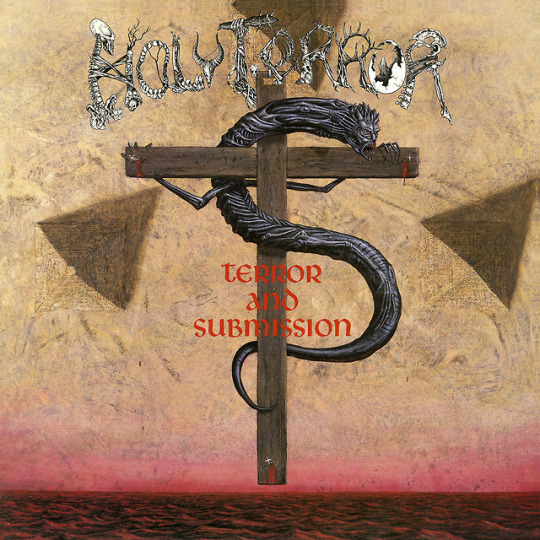

MINDWARS (ex-Holy Terror) To Release New Studio Album "Do Unto Others" on Dissonance Productions
Mike Alvord’s MINDWARS release their third and most accomplished album to date, "Do Unto Others" on Dissonance Productions, on April 13, 2018. MINDWARS and HOLY TERROR fans won’t be disappointed: 11 tracks of well constructed, dark thrash metal with thought provoking and questioning lyrics. "Do Unto Others" is a disturbing journey into the dark world we live in, let this be the sound track to the demise of the new world order!
MINDWARS "Do Unto Others" - CD out on Dissonance Productions on 13/04/18
Vinyl edition to be issued via Back On Black on 15/06/18
MINDWARS Facebook page: www.facebook.com/mindwarsband
HOLY TERROR Facebook page:www.facebook.com/holyterrorofficial
Mike Alvord walks us through each track:
"The Fourth Turning" - The opening track jumps through the speakers with thundering double bass drums, pounding bass guitar, and thrashing guitars. "The Fourth Turning" has the power and aggression capturing the tone of a pure thrash album. The lyrics were inspired by William Strauss and Neil Howe’s look at the historical cycles and distinct patterns in human history. The disorder within the world and the control by the political elite is a recurring theme on "Do Unto Other"s.
"I Am The One" - Many leaders in society claim to be "The One" who can provide the masses with whatever they desire. The song begins with an epic old school thrash feel and transitions to a mid tempo march leading to a first person chorus chant of "I Am The One". The song bursts into an all out speed frenzy through a frantic solo bouncing between speed and dive bombs. The song ends with the antagonist shouting he is the one to save, rape, and ultimately kill us all.
"Blacklisted" - This juggernaut starts at full speed and never lets up. Galloping through lyrics of surveillance and censure, blacklisted flies through the depths of secret surveillance. Our privacy is no longer. We are all being watched on multiple levels and are at the mercy of social media and the government. Do we have control? Do we have freedom? If this song doesn’t boil your blood… what will?
"Conspiracy" - This song brings us to the heart of the album. What is real and what is fake and full of lies? Conspiracy theories are all around us, from 9/11 in the US to the life of Jesus Christ and everything in between. Is it the elite trying to manipulate the world or are they just that… conspiracy theories? The song drives this question through a Germanic tempo which leads to a mid tempo bridge and Egyptian style solo. Soon enough the song takes us back to the pounding drive and encapsulating with the idea of a Deep State!
"In God’s Name" - This is the slowest song on the album and was inspired by the David Yallop book of the same title. It carries on the conspiracy theme and questions how Pope John Paul I really died. Some believe that John Paul I was uncovering the corruption of the IOR and P2 Lodge, therefore he was assassinated. The slow drive of the verse and chorus soon give way to a galloping high-speed bridge and solo. The song circles back to the question of what really happened.
"Allegiance Of Death" - ATD as the band refers to this song returns to the speed and thrash of what is MINDWARS. It begins with a marching beat before the speed sets in. The song questions the struggles of the men and woman of any military. They give their all, but for what? They truly pledge their allegiance to death by paying the ultimate price. The speed of the song breaks to a pounding mid section chanting about the people fighting the wars as puppets for the political elite. It ends with a full out thrash dual style solo.
"Wall Of Fire" - Scientology has always been an interest and this song looks at the OTIII and the secret advanced technology doctrine of the Church. After hours of auditing the follower can eventually advance to the third level Operating Theatan. This song is the shortest song on the album and is a combination metal mid-tempo song with various punk rock influences. Keep reaching higher and you too can become a member of L Ron Hubbard’s twisted society.
"Kill Or Be Killed" - The song begins with a dark and haunting opening. It sways back and forth through an evil grinding tempo. It transitions through various musical tempos and segments with vocals, solos, and 70s style rock. Lyrically this song departures a little from the over arching political theme of the album, but stills revolves around the controlling of others. Munchausen by proxy is a psychological disorder where you control people, usually your children by convincing them that they are really ill by exaggerating and making up symptoms. The person has no choice but to Kill or Be Killed or do they… Do unto others as you would have them do unto you!
"Peace Through Violence" - Returning to speed and thrash once again, "Peace Through Violence" opens with a New Wave of British Heavy Metalesque intro and capitulates to a fast driving pace. The song was inspired by Sun Tzu’s military strategy in "The Art Of War". Walking through this strategy, one will subdue and trick their opponent into a sense of self-confidence. That’s when you ATTACK!
"New World Order" - This was supposed to be the last song on the album because it brings to a close the Fourth Turning, conspiracies, and control, and leads us to our New World Order. Not a traditional thrash song by any means, but the galloping tempo drives the listener through their consciousness and brings them into the new order with a frantic and frenzied mid-section and solo. It returns to the memorizing and hypnotic intro before finishing with the ultimate distraction and control of the New World Order.
"Take It All Away" - Unfortunately the album didn’t end with New World Order. This song was written in just about 15 minutes right after the untimely death of Chris Cornell. Cornell’s death rocked the music world and this is our tribute to this amazing artistic person. We aren’t really sure where this song came from, because it does sound a bit different than the rest of DUO, but we felt it only appropriate to include it as the final track.
2 notes
·
View notes
Photo

The Crewe murders part 3 Despite his wife and cousin giving him a strong alibi for June 17, Thomas was sent for trial on a charge of murdering the Crewes. The prosecution suggested Thomas's wife, Vivien, had been the woman seen at the Crewes' house, although she was not charged. The witness was certain Vivien Thomas, who he knew, was not the woman he saw. The prosecution said the motive for the murders was that Thomas had been obsessed with Jeannette, an accusation for which they provided very little evidence. A witness who did give testimony supporting the prosecution's contention that Jeannette had been pestered by Thomas was Demler; he was cross examined about why he had not mentioned such obviously relevant information before the court had begun sitting. Thomas was found guilty of the murders in a 1971 trial, but the conviction was overturned on appeal. He was tried again in 1973 and convicted. Supporters of Thomas started a campaign to bring to public attention that the key evidence against him had serious anomalies. A campaign, led in part by Pat Booth of the Auckland Star, was largely responsible for getting Thomas released with a pardon. Campaigners said forensic work by Dr Jim Sprott had shown that the cartridge case had been planted at the scene and that its method of construction identified it as being from a batch that could not have contained the number 8 bullets recovered from the victims. Following David Yallop's book about the case, Beyond Reasonable Doubt, Thomas was pardoned by the Governor-General in 1979, on the recommendation of Prime Minister of New Zealand Robert Muldoon, and released after serving nine years in prison. He was paid NZ$950,000 compensation for his time in jail and loss of the use of the farm. A Royal Commission of Inquiry was ordered to review the wrongful conviction of Thomas and reported to the Governor-General in November 1980. The Commissioners found that the spent cartridge case from Thomas' gun, Exhibit 350, had not been left by the murderer, but had been created weeks later by police using his impounded gun and ammunition, then planted at the Crewes'. #destroytheday https://www.instagram.com/p/BtL4uyxhSws/?utm_source=ig_tumblr_share&igshid=1m4cz1tg3zw3n
0 notes